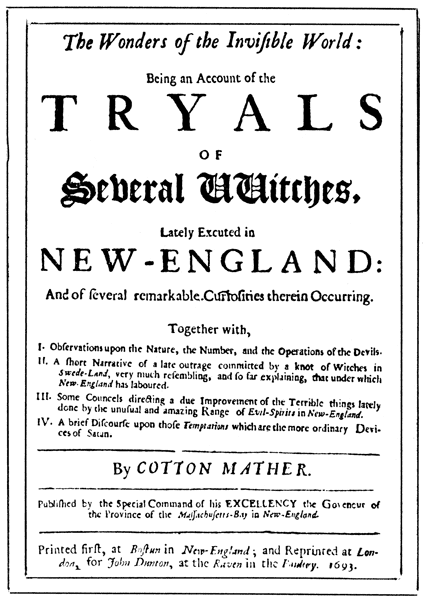


“The sense of vulnerability produced by ongoing conflicts with the Indians contributed to fears of and a series of narratives about witchcraft in New England.”
Video edited by Olivia Cambern using the public domain film, Häxan.
Music: “Ghost Story” Kevin MacLeod (incompetech.com)
Licensed under Creative Commons: By Attribution 3.0 License
http://creativecommons.org/licenses/by/3.0/
In January of 1692, two Puritan girls, Betty Paris and Abigail Williams, set off the most notorious witch hunt in American History when they claimed to be tormented by the spectral forms of several witches living within Salem Village. The Massachusetts Bay Colony was already strained after a devastating war with the Powhatan Confederacy, an increase in the number of Quakers and Anglicans moving to the colony, and economic changes caused by the emergence of a mercantilist class. When combined with pre-existing anxieties, these new fears proved a deadly mix.

Following the events of the Salem Witch Trials, Puritanical attitudes towards the wilderness became ever more severe as the wilderness came to represent both a place of literal evil and an active enemy seeking to destroy the colony.
Cotton Mather, a prominent religious figure of his era, penned “The Wonders of the Invisible World” as a defense of the Salem Witch Trials. His writing typifies the Puritans’ esoteric view of the world around them, revealing their steadfast belief in literal evil.
“And so much of the Church, as was Fled into this Wilderness, immediately found, The Serpent cast out of his Mouth a Flood for the carrying of it away. I believe, that never were more Satanical Devices used for the Unsettling of any People under the Sun, than what have been Employ’d for the extirpation of the Vine which God has here Planted”
Echoing the ideology of the earlier Winthrop, Mather highlights the Holy claim of the Puritans to the New World when he describes “the Vine which God has here Planted” (Mather, 202). Yet, Mather also expands upon Winthrop’s assessment of the wilderness by attributing any and all challenges the Puritans faced in creating their colony to a sinister plot by the Devil himself. Instead of a passive land to be conquered or a challenge to overcome, Mather posited the wilderness as an extension of the Devil’s evil intentions. In this sense, Mather echoed Bradstreet as well, for his interpretation of chaotic events mimics the idea of divine providence, but from the Devil as opposed to God. Yet, just as with Bradstreet, this mechanism of ordering a chaotic world proved a double-edged sword, for how were Puritans to know whether God, or the Devil, was responsible for any unexpected event?
